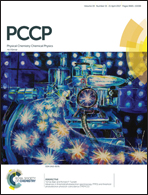Inclusion of lipopeptides into the DMPC lipid bilayers prevents Aβ peptide insertion†
Abstract
Using an all-atom explicit water model and replica exchange with solute tempering molecular dynamics we have studied the binding of Aβ10–40 peptides to the mixed cationic bilayers composed of DMPC lipids and C14-KAAK lipopeptides (LPs). Using as a control our previous replica exchange simulations probing binding of the same peptide to the zwitterionic DMPC bilayer we assessed the impact of lipopeptides on the Aβ binding mechanism. We found that binding to the mixed DMPC + LP bilayers does not enhance the Aβ helix propensity as much as binding to the pure DMPC bilayers. Tertiary interactions also differ in the peptide bound to the DMPC + LP bilayers due to a reduced helix content, salt bridge disruption, and the formation of new long-range hydrophobic interactions. More importantly, we showed that mixing lipopeptides into the DMPC bilayers prevents Aβ10–40 insertion forcing the peptide to reside on the bilayer surface and considerably destabilizes Aβ–bilayer interactions leading to the formation of a shallow water layer between the peptide and the bilayer. Furthermore, we demonstrated that Aβ10–40 peptides cause minor DMPC + LP bilayer thinning and perturbation beneath their binding footprint. These observations stand in sharp contrast to Aβ10–40 binding to the pure DMPC bilayers, which results in deep peptide insertion and significant disruption of the bilayer structure. We argued that lipopeptides expel Aβ10–40 peptides from the bilayer due to strong, mostly electrostatic, interfacial interactions introduced by the lipopeptides into the bilayers. We therefore propose that C14-KAAK lipopeptides can be used to engineer lipid bilayers, which withstand binding of Alzheimer's Aβ peptides.



 Please wait while we load your content...
Please wait while we load your content...